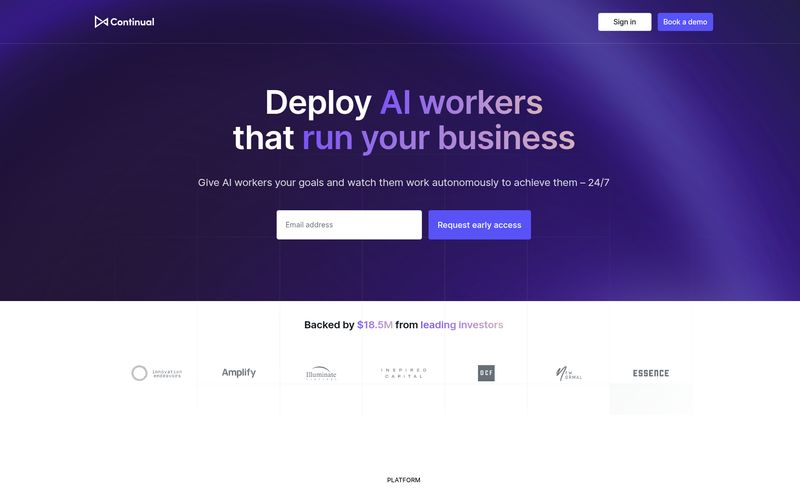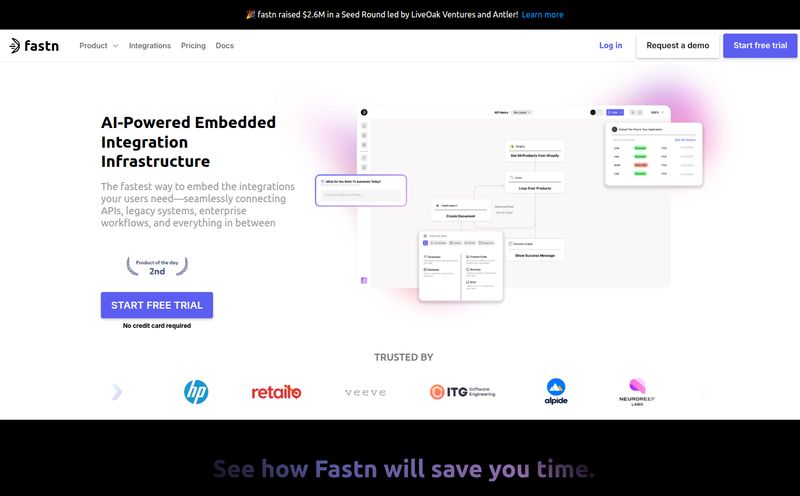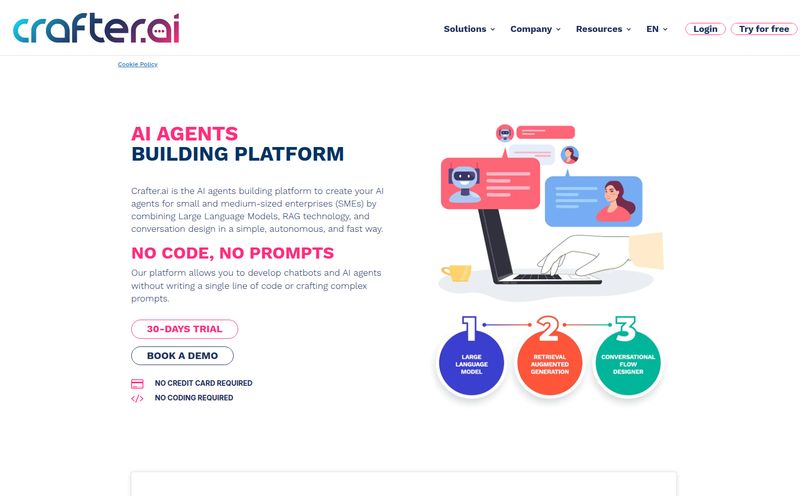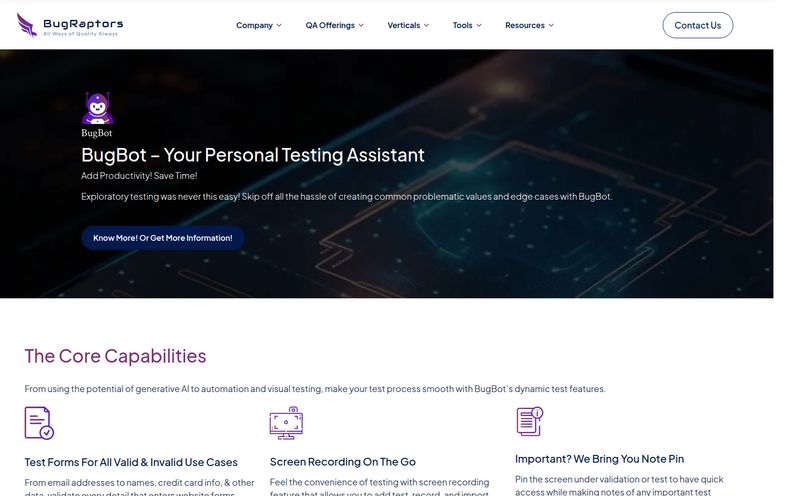If you're a developer, you know the drill. That initial spark of a brilliant idea hits you, and you're ready to build the next big thing. But then... reality sets in. The boilerplate. The endless setup. Configuring the server, connecting the database, creating the same old CRUD endpoints for the hundredth time. It's a momentum killer.
I’ve lost count of the number of side projects that died a slow death in the `init` phase. It's not the fun part. It’s the necessary evil before you get to the actual creative work. For years, we've just accepted this as part of the job. But with the recent explosion of AI in the tech space, I've been wondering: can't a robot do this for me?
Well, it turns out, one is trying to. I stumbled upon a tool called Backendr.ai, and the promise was just too good to ignore: "Generate Backend APIs with AI." My curiosity was piqued. A tool that could take a simple prompt and spin up a whole Node.js backend? Sign me up. So, I poured a coffee, opened a new tab, and decided to see if this thing was legit or just another drop in the AI hype bucket.
So, What on Earth is Backendr.ai?
At its core, Backendr.ai is a browser-based platform that uses artificial intelligence to instantly generate a Node.js backend for you. You don't download an app or install a complex CLI. You go to their website, type what you need into a text box, and hit 'Generate'. It’s almost laughably simple.
It's not just spitting out random code, either. It specifically builds a project using a pretty standard and popular stack: Node.js and Express.js for the server and routing, with MongoDB as the database. For anyone who's worked with the MERN (MongoDB, Express, React, Node) stack, this feels immediately familiar. It’s like it’s speaking our language.
The idea is to take your plain-English requirements—something like “Create a user authentication system with endpoints for login, signup, and profile updates”—and translate that into functional code, complete with API routes and database models. It's like having a junior dev on call 24/7, but one that runs on electricity and doesn't need coffee breaks.
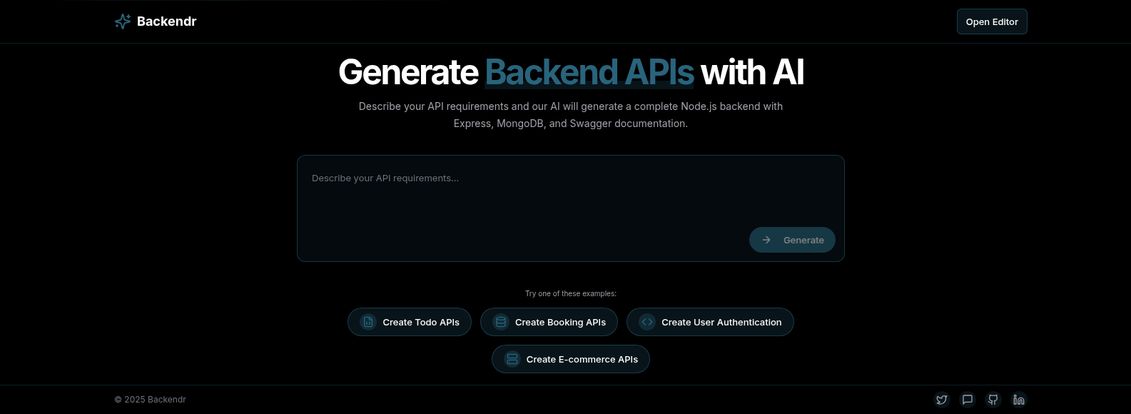
Visit Backendr ai
My First Impressions and a Quick Test Drive
Landing on the Backendr site is a clean, no-fuss experience. It's a dark-mode interface with a big prompt box front and center. It gets straight to the point, which I appreciate. No marketing fluff, just a clear call to action: Describe your API requirements...
To kick the tires, I decided to try one of their pre-filled examples: "Create E-commerce APIs." I clicked it, the prompt box filled up, and I hit Generate. A few moments later, a full-fledged editor appeared right in my browser. On the left, a file tree with `controllers`, `models`, `routes`, and a `server.js` file. On the right, the code itself. It was… impressive. It had generated models for Products, Users, and Orders, and all the corresponding API routes. Wow.
This wasn't just a code snippet; it was a structured, downloadable project. This immediate feedback loop is incredibly powerful, especially for prototyping.
The Core Features That Actually Matter
After playing around for a bit, a few features really stood out to me as being more than just gimmicks. These are the things that could genuinely change a developer's workflow.
AI-Powered Project Scaffolding
This is the main event. The ability to go from an idea to a full project structure in seconds is the biggest selling point. Think about hackathons or proof-of-concept projects. The amount of time you save on setup is enormous. Instead of spending your first two hours configuring your `package.json` and writing a basic server file, you're already building out your unique features. That’s a game changer.
The In-Browser Live Editor
I have to admit, I'm usually skeptical of browser-based IDEs. They can feel clunky or slow. But this one felt surprisingly snappy. The fact that you can immediately tweak the AI-generated code without having to clone the repo, run `npm install`, and open VS Code is a massive convenience. You can make a quick change, test an endpoint right there, and then decide if you want to download the whole project. It lowers the barrier to experimentation.
Automatic Swagger Documentation
Okay, raise your hand if you enjoy writing API documentation. Anyone? I thought not. Backendr automatically generates Swagger (OpenAPI) documentation for the APIs it creates. This is a godsend. It means your API is documented from the second it's created, making it easy for frontend devs (or your future self) to understand how to use it. This feature alone could save a team hours of tedious work and prevent so much confusion down the line.
The Good, The Bad, and The AI-Generated
No tool is perfect, right? Especially one that's this new and ambitious. Let's break down the highs and the potential lows.
On the plus side, the speed is undeniable. For rapid prototyping, creating backends for small freelance gigs, or for students learning how server-side applications are structured, this tool is fantastic. The accessibility is also a huge win. Being able to build a backend from literally any computer with a web browser is liberating. You're no longer tethered to your main development machine.
However, we need to talk about the potential hiccups. My main concern is the risk of over-reliance. The AI generates solid boilerplate, but complex, custom business logic will still need a human touch. A junior develeper might be tempted to use the generated code as a black box without truly understanding it, which can be dangerous. Secondly, there’s the question of platform dependency. You're building on Backendr's turf. While you can download the code (which is great!), any updates or changes might mean going back to their platform. It’s something to be mindful of for long-term project maintenance.
So, How Much Does It Cost?
This is where things get interesting. Naturally, after being impressed by the tech, I went looking for the pricing page. It's the SEO professional in me; I always want to know the business model. And I clicked... and I found a 'No pricing instance found.' page. A 404 error, basically.
As of right now, there is no public pricing information available for Backendr.ai. My guess? The platform is likely in a public beta or an early-access phase. They're probably gathering user feedback and refining the product before they slap a price tag on it. This is good news for us, as it means you can likely try it out for free right now. But it also leaves big question marks around future costs and scalability for larger applications. I'll be keeping a close eye on this one.
Who is This Tool Really For?
After my deep dive, I have a pretty good idea of who gets the most out of Backendr.ai today:
- Indie Hackers and Solo Founders: Need to get an MVP out the door fast? This is your secret weapon.
- Frontend Developers: Want to build a full-stack application but the backend is your weak spot? Backendr can give you a massive head start.
- Students and Learners: It’s a fantastic way to see how professional Node.js projects are structured without getting lost in the weeds.
- Prototyping Teams: Perfect for spinning up a quick, disposable backend to test a new feature or app concept.
Is it ready to build the next Netflix? Probably not. The lack of clarity on scaling and the potential for custom logic bottlenecks mean it's not quite an enterprise solution. But for its target audience, it hits a real sweet spot.
Frequently Asked Questions about Backendr.ai
Is Backendr.ai free to use?
Currently, it appears to be free. There is no pricing page available, which suggests it's in a beta or free-to-try phase. This could change in the future.
What technologies does Backendr.ai support?
It generates backends using Node.js, Express.js for the server and API framework, and MongoDB for the database. It also automatically creates Swagger documentation.
Can I download the code generated by Backendr.ai?
Yes. After generating the project, you have the option to download the entire source code as a zip file. This is a key feature that prevents complete platform lock-in.
How does this compare to something like GitHub Copilot?
They solve different problems. GitHub Copilot is an AI pair programmer that assists you while you code by suggesting lines and functions. Backendr.ai is a project scaffolder that generates the entire initial project structure and boilerplate code before you start coding the fine details.
Do I need to know how to code to use Backendr?
To get the most out of it, yes. While it generates the code for you, you'll need programming knowledge (specifically JavaScript/Node.js) to customize the logic, add unique features, and properly deploy and maintain the application.
Is the generated code production-ready?
I would say it's "prototype-ready." The generated code is a fantastic starting point, but for a production environment, you would absolutely need to conduct a thorough security audit, add comprehensive testing, and implement more robust error handling.
My Final Verdict
So, is Backendr.ai a gimmick or a genuinely useful tool? In my opinion, it's firmly in the 'genuinely useful' camp, with a few caveats. It’s not going to put backend developers out of a job. If anything, it’s going to make their jobs less tedious. It automates the boring stuff, the repetitive setup that we all dread, and lets us focus on solving actual problems.
I'm excited to see where the platform goes from here, especially once they introduce a clear pricing and scalability model. For now, it’s an incredibly promising tool that offers a glimpse into a future where getting an application off the ground is faster and more accessible than ever. Give it a spin; it might just save your next side project from the boilerplate graveyard.
